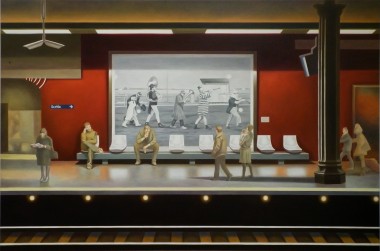The first thing in the paintings of Anastassia Bordeau that strikes the eye is the absence of natural lightning. The firmament with moon and stars has totally vanished from her horizon: space has lost its sublunary nature (hypaithrios), even as a tangible presence of the earth, the ground is, on the contrary, stressed by the traffic signs. Headlights and lampposts transpierce the gloom, while neon lamps with their sharp, pointed beams paint the night by white, yellow, green splashes of varying intensity. No haze, no glimmer anymore, but the primordial Colour standing out against the Shadow.
Another characteristic feature of the series is the absence of Man. It’s this very trait that so conspicuously distinguishes them from the artworks by Edward Hopper (1882-1967), the painter hardly to be omitted in the context. In his paintings, such as “Night Windows”, 1928 (Museum of Modern Art, New-York) and “Night Birds”, 1942 (Art Institute, Chicago), human figures arrayed in clinging garments stand motionless, as if under a spell. Peeping out through the display windows, his personages flaunt their passivity and inability to communicate; still, they are undoubtedly human, men or women. Bordeau’s world is just the opposite: her benches, cars, cafes, filling stations have never stood for a journey, an action, or a sign of ordinary life. This world is at least for a time deserted, devoid of human presence.
After all, the third feature one has to note is the total absence of any plant or animal life. We are plunged into the depths of mineral world, where triumphs the glass with its playful ability of optic effects – either of transparency or of reflection. Could the trap be avoided? “Beware, Danger!” And so warns the train of brown signs flattened in S-shapes: stop needed, otherwise you could stumble on an invisible surface; they indicate the dangerous proximity of the edge.
No stars, no people, no plants…The night of Anastassia Bordeau is urban and deserted at the same time, yet it lacks disquiet or unease. Quite the reverse, this night is pretty snug, bringing back the intimacy of mother’s womb, where you can hide and escape all troubles. Here we are plunged into the shadow, stay sub umbra, as Hugo put it; but the obscurity of this shadow (Umnachtung) keeps its affable spirit.
It’s neither the night that emanates discomfort, nor the eyes of street lights and cars. Uneasiness is rather the effect of broad, sharp light that illuminates half-naked, often dismembered bodies: smooth, cold and beautiful, but frigid; those bodies on display are often inappropriate, excessively lush, overly academic. They look like the candid advertising images exposed not for pleasure, but for sale.
A recurrent motif in Anastassia Bordeau’s works is a transparent glass cage where the bodies are enclosed whether it is a telephone box or a bus stop shelter. Despite the welcoming whiteness of a bench, those cages reject any possibility of encounter. The Temple of Present Tense, the Temple of Today Life - it’s the place where there is no place for true sensuality, whilst insolent luxury runs the show. It is the Temple of Heartless Symbols and Love Profaned, the Temple or, if you wish, anti -Temple of Luring Lust - anonymous, for sale together with the neon lights of a big city. This cult – “to appear, but not to be” - seems to have torn away from things all the tokens of intimacy and turned them into mere illusions. Extract from the text Flowers of the Night by Baldine Saint Girons, Professor of the Universities in the University Paris X – Nanterre







